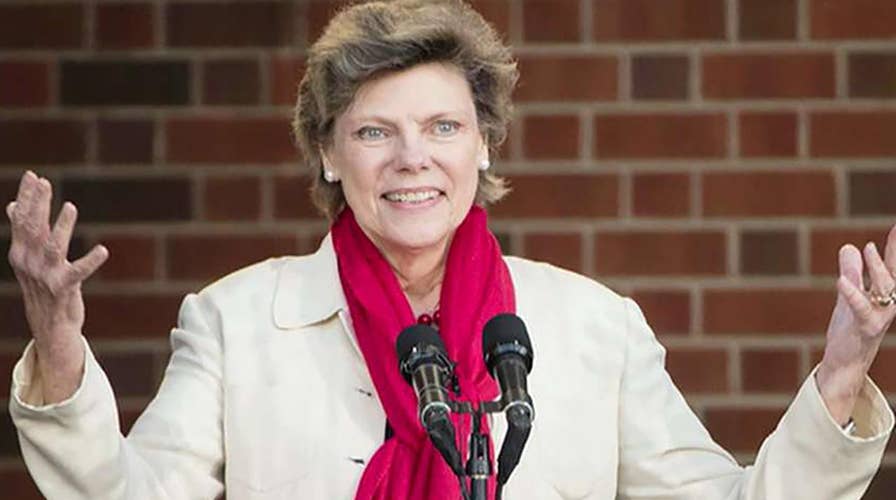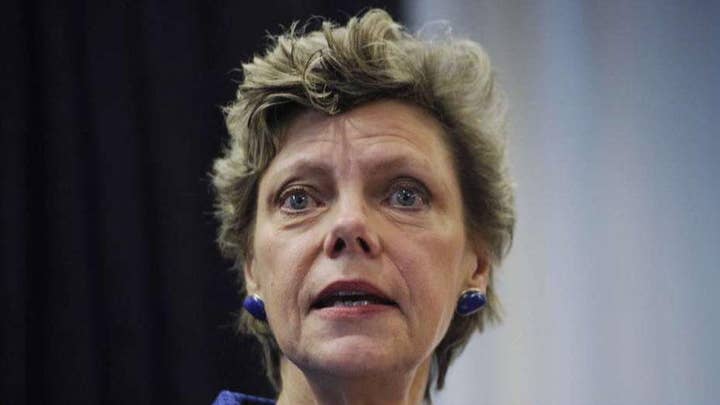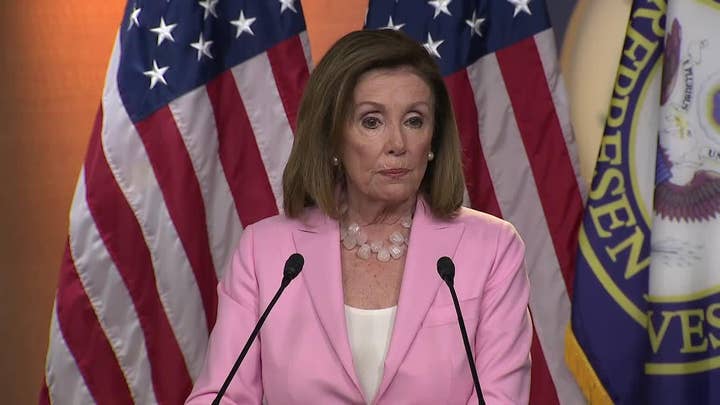ABC journalist Cokie Roberts remembered as trailblazer
Cokie Roberts dies due to complications from cancer; Kristin Fisher reports from Washington.
CAPITOL HILL – Cokie Roberts couldn’t talk to me at that particular moment.
That’s understandable.
She was doing her job.
And, at the time, I was trying to get one.
It was September 1993. I had just arrived in Washington, fresh out of graduate school at Miami University (of Ohio). I was looking for a job in Washington and wandering around on the plaza on the east front of the U.S. Capitol, near the Senate steps. I had been to Washington only once before. Now, I hoped to work here, preferably as a journalist. And, at that moment, Roberts - with an ABC News camera crew in tow - was in pursuit of Sen. Daniel Patrick Moynihan, D-N.Y.
The honeymoon had just ended for then-President Clinton. A legislative fight loomed over a national health-care program, “Hillary Care,” as it was dubbed. The first lady molded the health care package behind the scenes and testified about the plan before congressional committees. Just a few days after I arrived in Washington, President Clinton spoke to a Joint Session of Congress to make his health-care pitch.
“There’s still a lot of people who say it would be an outright miracle if we passed health-care reform,” the president said in his address.
Democrats held both the House and Senate in those days. Moynihan would be key to shepherding a health-care bill to passage. After all, Moynihan chaired the Senate Finance Committee, one of the main panels with jurisdiction over health care.
But, Moynihan was a skeptic of the proposal.
This was why Cokie Roberts wanted Moynihan.
I immediately understood the news gravity of the moment. I knew why Moynihan’s stand was crucial to the health-care debate and why this was a story for ABC.
Just a few moments before, I was at the Dirksen Senate Office Building and spotted Sen. Dennis DeConcini, D-Ariz., crossing Constitution Avenue toward the Capitol. Before then, I had met only one U.S. senator in person. I was proud I recognized DeConcini and I briefly introduced myself. The senator shook my hand. But, the reason I knew DeConcini was because he had been caught up in the “Keating Five” ethics scandal. DeConcini wouldn’t seek re-election in 1994.
The top of the Capitol dome was bare at that stage. A gigantic helicopter had lifted the Statue of Freedom off the dome for some repairs earlier in the year. The statue itself then stood on the Capitol plaza, cordoned off behind a chained-link fence. Onlookers gathered around the statue to see it up close before workers would return it to its perch atop the dome.
And then, down the Senate steps came Moynihan.
I had worked in radio news since high school in Cincinnati at WKRC-AM. I watched the Sunday talk shows each weekend. I knew who Daniel Patrick Moynihan was because he was a fixture on TV and in the newspapers. I had just purchased a gigantic copy of Congressional Quarterly’s “Politics in America.” I remembered that Moynihan listed “Pindars Corners, N.Y.” as his hometown.
“Hello, senator,” I said to Moynihan.
“I’m coming over here to look at the statue,” Moynihan said in his inimitable style. He drew out the final syllable of the word “statue” through the middle of next week.
I started to ask Moynihan about the statue. But, my time with the senator had expired. Here came Cokie Roberts. An ABC photographer jogged behind, his camera fixed like a shoulder-mounted missile. An ABC soundman followed, an intricate spaghetti weave of cables dragging across the asphalt.
“Whoa,” I thought.
We were in the big leagues here. First, DeConcini, then Moynihan, and now, Cokie Roberts and ABC News? Welcome to the show. This wasn’t like what I was used to seeing in Cincinnati. This wasn’t like interviewing Butler County Sheriff Richard Holzberger on the steps of the county courthouse.
Then, it hit me.
NPR.
I specifically hung around Miami University for a couple of years to earn my master’s degree and work at WMUB-FM, the university’s NPR station. At WMUB, I hosted an afternoon news program which aired before “All Things Considered.” I covered local city council meetings, crime and politics - including a freshman congressman named John Boehner. We always wondered what happened to him.
But now, I was standing at the Capitol, and here was Cokie Roberts. Could this be my “in?”
I didn’t know anyone at NPR. You have to remember, this was 1993. I had mailed numerous resumes and tapes to NPR. I called NPR constantly to follow up. I found myself marooned in a cul-de-sac of voicemail. I never once reached the actual person with whom I needed to speak about a job.
Here was Cokie Roberts. Back then, there were three people I would never miss on NPR: Frank Deford, Red Barber and Cokie Roberts. I had heard Roberts de-brief “Morning Edition” host Bob Edwards about politics and Capitol Hill for years. I even remember where I was on Middletown Oxford Road in Ohio in 1990 when Roberts was doing an early morning two-way with Edwards about the economy – and a dog started barking in the background.
The barking didn’t surprise me. I worked in radio and knew what a “remote” sounded like. Although they never said it on the air, it was obvious to me that Roberts wasn’t in the studio during these pre-dawn chats. Her voice sounded tinny and echoed. I pictured Roberts speaking from a wooden study in her home, a jerry-built microphone rigged to an old desk. Edwards’ bass obviously emanated from a studio. I suspected Roberts was either on what was known as a “Comrex” line or something called “Switched 56.” These essentially were enhanced phone lines. Radio stations often used those systems to broadcast football and baseball games. They sounded close to studio quality, but someone in the industry could tell the difference.
A week later, I was driving at nearly the same spot on the road when Roberts was on with Edwards again.
“Well, Bob,” said Roberts, “our dirty little secret is out. Most mornings when you and I have our conversations, I must admit it, I am in my very discreet nightie.”
The dog? It was Roberts’ basset hound, Abner. She described him as “about 4 years old, brown and white, very long ears and very sad eyes.”
Roberts worked mostly at ABC at that point. I had seen her on ABC’s “This Week With David Brinkley” alongside Brinkley, Sam Donaldson and George Will. I knew that her father was the late House Majority Leader Hale Boggs, D-La. Boggs served on the Warren Commission, investigating the Kennedy assassination, and was said to have died in a plane crash in Alaska. But, even though Roberts “day job” was at ABC, she still appeared regularly on NPR.
My mind raced.
Maybe she would take a few minutes to talk to a young journalist? Perhaps put me in touch with someone at NPR or ABC? Anything to get a foot in the door.
I played the NPR card since we had that in common.
EX-NEW YORK TIMES BOSS DEFENDS BRETT KAVANAUGH ARTICLE
I introduced myself to Roberts and immediately told her how I worked at the NPR station in Ohio. I asked if she had any advice. I thought the NPR part might resonate with her.
Cokie was very polite, but it was immediately clear she couldn’t stop to talk. She told me she was working on a story for “Nightline” and had to talk to Moynihan.
Roberts never broke stride, squeezing the microphone with a grip that would make you think she was clutching the Holy Grail. Meantime, Moynihan’s 6’5” frame ambled away, bound for the Statue of Freedom. The soundman hopscotched over his tangle of cords in an effort to keep pace with Roberts, determined not to lose her quarry.
I sighed.
I understood. After all, I was a reporter, too.
I stood slightly out of earshot as Roberts interviewed Moynihan. The senator talked about premium caps and pre-existing conditions. I could hear only about every other word and not be in the picture.
I was a little dejected. But, Roberts was doing her job, and I learned something from Cokie Roberts even though we didn’t really talk:
Do your job. Get the story. Don’t let other things distract you.
These days on Capitol Hill, I often think of that brief interaction with Cokie Roberts. I find myself amid a horde of scribes chasing House Speaker Nancy Pelosi, D-Calif., through Statuary Hall. Tourists are all around, wondering what’s going on. Maybe I’m somewhere on the Capitol plaza, close to where Moynihan was, trying to catch up with elusive Senate Intelligence Committee Chairman Richard Burr, R-N.C. – or, not-so-elusive Senate Judiciary Committee Chairman Lindsey Graham, R-S.C.
The lesson stuck.
Do your job. Get the story.
This past July, I sprinted through the Cannon Tunnel, trying to channel John Ross eluding a defensive back. I was trying to get on the air from the Fox News camera in the Cannon Rotunda.
Rep. Doug Collins, R-Ga., had just tried to sanction Pelosi on the floor for her language about President Trump. I knew such an occurrence hadn’t unfolded in the House since the mid-1980s with House Speaker Tip O’Neill, D-Mass. Never breaking stride, I shoved my IFB earpiece into my ear and slid into an elevator in the Cannon Building. I was panting, fishing my notebook out of my pocket. The control room in New York was calling my phone, trying to get an explanation about the imbroglio on the House floor.
The elevator door closed.
Inside the elevator was a polite man, clearly from out of town, who recognized me. He said he saw me on the air and liked my work. He wanted to talk.
Out of breath, I apologized profusely. I thanked him for watching. But, I told him there was some breaking news. I handed the man my card and told him I was sorry I couldn’t chat. I felt badly, but I had to get on the air.
CLICK HERE TO GET THE FOX NEWS APP
I arrived at the third floor and squeezed out of the elevator.
I hope the man understands.



